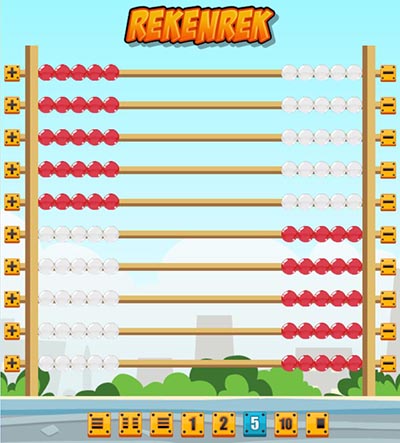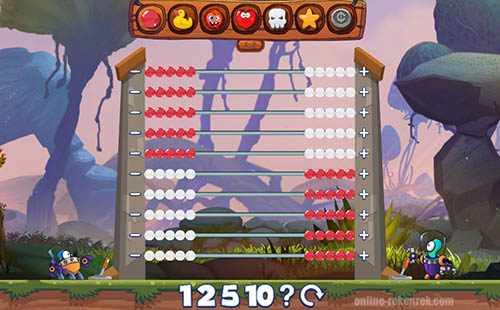Rekenrek 1 to 10
Online Rekenrek 1 to 10
Rekenrek Bead String – 10 Rows – Rekenrek 1 to 10
9 More Ways to Use a Rekenrek 1 to 10 to Improve Number Sense
The Rekenrek 1 to 10 is a Math manipulative used in elementary classrooms around the world. This simple tool, which traditionally consists of two rows to 10 beads (5 red and 5 white), has so much to offer teachers and students. The more you read about and use a rekenrek in your classroom, the more ways you’ll discover just how valuable it can be for helping students improve their number sense and grasp important math concepts.
In addition to real world rekenreks, electronic rekenreks are also very useful for math instruction. It is so handy to have a large one one the classroom wall while the students have ones they have made for themselves.
One-to-One Correspondence:
For younger students, rekenreks can be a concrete tool to use to help them develop one-to-one correspondence as they work on their counting skills. They can physically move one bead each time they say a number while counting.
Skip Counting:
Similarly, you can also work on skip counting with older students. Choose a number to skip count by (2s, 5s or 10s work well) and model moving that number of beads as you count. Depending on a student’s understanding of skip counting, they’ll be able to check their answer by counting the beads.
Modeling Numbers in Multiple Ways:
Students can work in a small group to find as many ways as they can to model a given number. For example, the number 7 could be made using 1 red bead and 6 white beads, 3 red beads and 4 white beads, 5 red beads and 2 white beads and so on.
Exploring Doubles and Near Doubles Facts:
Rekenreks can also be used to help students learn about doubles and near doubles facts. Students can experiment with finding the different doubles facts (or near doubles facts) they can show on their tool. For example, lining up 6 beads on top and 6 beads on the bottom would show 6 + 6 and 6 beads on top and 7 beads on the bottom would show 6 + 7.
Exploring Rainbow Facts / Facts to 10:
Rainbow facts refer to pairs of numbers that have a sum of 10, such as 4 + 6. Students can work with one row of beads to discover all the different pairs of numbers that equal 10.
Exploring Turnarounds with Addition:
Encourage students to use their rekenreks to prove addition turnarounds, like 5 + 8 and 8 + 5, have the same sum.
Exploring Turnarounds with Addition and Subtraction:
Students can use their rekenreks to explore turnarounds with addition and subtraction as well. They can use two rows of beads to experiment, find, and prove different addition and subtraction turnarounds, such as 6 + 7 = 13, 13 – 7 = 6 and 13 – 6 = 7.
To Improve Understanding of Place Value:
Another way rekenreks can be used is to help students develop a deeper understanding of place value. Have students use two-row rekenreks to model and explore different two-digit numbers. They can use the top row to represent the tens place and the bottom row to represent the ones place.
Visually Represent Story Problems:
Have students use rekenreks to make a visual representation of a story problem to help them find the answer. For example, start by reading students the problem, “Susan took $10 to the shops and spent $3. How much money does she have left?” Students can first model the $10 she started with using 10 beads, then they can pull of the $3 she spent using 3 beads. They’ll be able to see that since there are 7 beads left that Susan must have $7 left.
Show Me a Different Way:
One student can press the random button on the electronic rekenrek to make a number. Then, the other student must build that number on their personal tool using a different bead arrangement. For example, is 8 is displayed a 5 and 3, they could also show is as 6 and 2 or 7 and 1.
Behind the Wall:
Have the alien pull the lever on the electronic tool to cover half of the board. Then, press the randomize button and have students identify how many beads are behind the wall. You could either do this as a whole group, or have students work with a partner and take turns explaining their thinking.
Copy My Moves:
Click on one of the number buttons along the bottom of the board (1, 2, 5 or 10) to set the number of beads that will be moved each time the plus or minus button is pressed. You can model skip counting on the board by the number you selected and have students skip count along with you and move beads on their personal rekenreks.
As you can see, rekenreks hold a lot of promise. There are so many different ways you can incorporate this tool into your daily math instruction to help students improve their number sense. How will you use rekenreks to help your students?

Try Out Some Our Other Rekenreks
or Maybe Our Original Virtual Rekenreks

|
|
|
